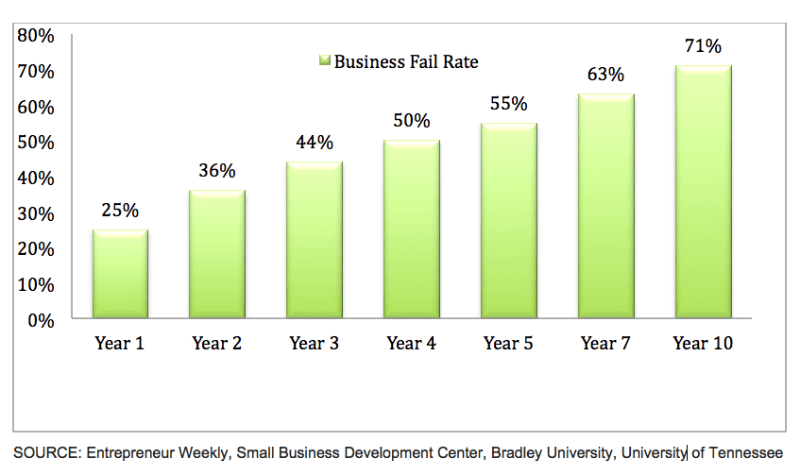Wondering why apps fail? Many entrepreneurs fall victim to the “positive thinking trap.” For them, “failure” becomes a forbidden word, a taboo, the worst thing that can ever happen.
When it comes to tech business and mobile application development, failure is the first thing to watch for.
You want your app and business to be successful, popular, and lucrative, right? It’s natural that you read articles like “How to Make a Gazillion Dollars with Your First App?,” “How to Get Funded,” and visualize your personal “app success story.” That’s perfectly okay. But, don’t get caught in just that one side of thinking.
Here’s an important secret: app success starts with analyzing why mobile apps fail, not why a single app out of thousands succeeds.
Find out why others didn’t make it, learn from their mistakes, ensure you won’t repeat them and your application will stand a chance in the noisy mobile marketplace.
So, let’s begin our journey. Here are the Top Three Reasons Why Apps Fail – miserably. Over half of the mobile apps on Google Play get few to no downloads. Over 60% of those that see decent downloads experience an 80% drop-off rate within the first week, never to be used again.
#1. Why Mobile Apps Fail? Wrong Ideas or Bad Execution
Most people are locked into a vision that their app ideas are outstanding. It’s natural to assume that something is unique and original for coming up with the idea in the first place. Yet, such thinking, while absolutely normal, is counterproductive.
If you have an app idea, stop building castles in the air. Instead, acknowledge a very simple and important fact: Most apps are poorly researched and badly executed. Sorry.
It’s easy to think that customers will love your app, but can you justify it? Did you:
- research the market?
- checkout our competitors and their apps?
- define a target market?
- test the idea with your target audience?
- run the numbers to see if your app will provide a return on your investment?
In short, did you do some real due diligence?
Due Diligence:
To start, analyze your user preferences by looking at the most popular apps in your category on the App Store and Google Play Store. There are tons of”‘top-X most popular apps” on the web. Take them with a great deal of skepticism. Lots of people try to sell stuff.
Instead, look at the free and paid charts in the app stores. Your goal is to spot trends and analyze them.
When you have some data on your hands, ask yourself whether your app idea fits into those trends. You’re very likely to have a rude awakening here, but let’s be honest: It’s better to have a quick but harsh reality check and come up with something new and great than go all-in on an idea that just doesn’t work.
Well, if you’ve spent enough time on data analysis, three questions will do just fine:
- How did you get the idea?
- Is your idea justified by market research?
- Or is it something you want to create just for the sake of it?
Don’t design and develop an app that YOU want. Unless your app really just is for your own purposes, that’s fine. However, if you intend to make money with your mobile app, focus upon what your customers want. Satisfy your customer’s needs while keeping originality, user experience and your business in mind.
Tough, right?

Failing Early and Often is a LOT less Painful
The crucial point in justifying your idea for an app won’t fail early on massively saves your time and money in execution. Ideas run a dime a dozen, execution is everything. You’ll need to find the right professionals to design, develop, and market your application.
A compelling, visually attractive design and a killer user experience are a must nowadays. If you’ve been digging deeper into the data, you know perfectly well that customers are picky and hate spending their time on poorly executed, non-intuitive apps. Stick to experiences that your users already like (based on what popular apps already do), but take that the extra mile. Take your users to a whole new level – make your app a joy to use and you’ll be rewarded.
So, to summarize, to guarantee a great user experience and bulletproof your app from the first reason why apps fail, look at other successful apps. What have they done well? What could they improve upon?
#2. Why Mobile Apps Fail? Lack of Proper Monetization Strategy
Most people, when going to develop an application, think that they will:
- design and develop the app;
- market it;
- get visitors and regular customers;
- make a fortune.
Many would-be appreneurs never get beyond the first step. Even if you do the design, development, and marketing right, you still need a viable monetization strategy. Count on every additional step being a huge struggle without one. Having money coming in really does make further development easier.
According to Gartner, only 0.01% of mobile applications will be considered financially successful by 2018. Why mobile applications fail often owe to being unoriginal, lacking important features, have no obvious target audience or suffer from mobile app development failures or have usability issues. Yet, the most common reason behind why mobile apps fail financially is that their owners can’t properly monetize the apps.
Great Ways to Monetize Your App
You are not limited to selecting just one monetization method. You can have as many monetization models as your development budget supports – understanding that each may require a module within your app.
- Premium app sales – though this cuts out advertisements and freemium unlocks.
- In-App Advertising – to be lucrative requires a large and loyal user-base.
- Freemium model – look at how F2P games work – pay for feature unlocks, in-app currency and other mechanisms. Understand that a small percentage of your users will be responsible for a majority of your revenue.
- Subscription model – recurring monthly billing, best applied to news and service-related applications. Again, look at online games for examples of hybrid and tier-subscription models.
- In-App Store – for sales of digital and physical merchandise.
- Vanity products and services – offer some of the most lucrative monetization options which can also be used during fundraising. Vanity items can range from custom avatars, unique in-app items or privileges.
- Newsletter promotions – Requiring user emails during registration provides you the option to run periodic newsletters – to promote your business, but also sets the stage for other cross-promotion opportunities and commissions on referrals.
- Creative alternatives – These depend on your app and target market but could include everything from monetizing user surveys, finding corporate sponsorships, running auctions or something specific to your niche – like with music, you could tap into royalties and royalty shares.
Undoubtedly, premium apps do make money, but free apps generally perform better. More than 90% of paid apps tick in less than 500 downloads per day. Note that premium apps put a hard cap on your revenue per user. Conversely, a properly structured F2P or Freemium model avoids such limitations.
Let users try before they buy.
An app can be like a storefront. How many stores insist upon a cover charge just to get in and look around? With premium apps, you see, people won’t pay for your app if they have no idea what it’s about. For that matter, users can easily find a free or freemium app with similar features.
So, that’s why your app monetization strategy should be built around providing maximum value and ensuring the best user experience. Don’t guess, do your research: download the top competitors’ apps and reverse engineer their idea. You should figure out what you like and what you hate, which features you’re ready to pay for, and which you’re not. Lather, rinse, repeat. Also, don’t forget about taking screenshots!
Offer the best part/s of your app for free to get loyal customers. As your app gains momentum, your monetization plans and options should be running full throttle. Look to offer new features and options over the course of your app’s life-cycle.
In-App Advertising Considerations
Mobile monetization through adding new features to the app is one thing; making a fortune on advertising is quite a different story. Basically, you should remember two important things:
- Data analysis and tracking are crucial to the success of your advertising strategy. Ensure you have a clear picture of how number of downloads correlates with advertising revenue and how users engage with the app after every iteration.
- Top apps enjoy much better revenue per download than regular ones. They get more traffic and, therefore, can run more tests and iterate at a greater speed. Top apps are more adaptable and successful in the long run.
Also, don’t forget about scalability, such as introducing your app to other markets, improving advertising options, adding more apps to create an App network, etc. Think long-term from the very start. Otherwise, your app will reach a plateau. Then, you’ll have to rethink the whole strategy on the go or even rebuild your app from the scratch.
#3. Why Apps Fail? No Perseverance in Iterating
App success is something you can’t achieve without a feasible app idea, a well-planned marketing plan, and a tested-through app monetization strategy. Yet, in a long list of mobile app failures, many ‘victims’ succumb to a lack of perseverance in iterating and tweaking the app.
The thing is, any app can be improved to be well worth the effort in the end; however, you need enough perseverance to gather data, change design and marketing strategy, and introduce new features. This road is full of trials and tribulations, but it’s the proper road to take.
It’s possible you may soon realize that general updates are too costly and time-consuming. Basically, it only means that you can either try to solve mobile app issues, or abandon the app, or run more tests to figure out how to increase downloads. Basically, you want to test:
- Images and icons (they’re what your customers see in the first place. Tweak and iterate relentlessly);
- Keywords (change keywords to make your app more searchable in its category);
- App reviews (make sure that you get positive reviews and work on negative ones. Reward users who leave reviews).
67% of developers find themselves below the “app poverty line.” Apps that failed share a few (or all) features: their strategy was not that well-planned, there were bugs in the functionality and the interface, the marketing was bad. Not working on your mistakes is the biggest sin, that’s one of the reasons why mobile apps fail to perform, even though the idea behind them was great.

So, tweak and iterate again and again. Don’t be lazy or hasty. You need data. You need a strategy. You need a quality, step-by-step execution process. Period.
Final thoughts
You can save your app from failure, though. To this end, you need to:
Identify a viable need for your app before you develop it.
Ensure quality execution.
Know how to monetize.
Iterate and analyze.
Dig deep into the data behind app consumption, analyze the trends, cherry-pick popular design decisions and app features, come up with an MVP to test your app idea.
Your app should feature a visually attractive but trend-focused design that looks and feels familiar to users. Essentially, a killer user experience is a must – users hate buggy applications that don’t do what they should. Bad UX is why mobile apps fail.
Don’t become one of these businesses that fail to capitalize on mobile apps. Effective app monetization is based on deep insights and analysis of trends, not on someone’s likes, dislikes or guesses. Offer the best part of your app for free but know when, where and how to generate revenue. Track the data relentlessly to increase downloads and improve your advertising strategy.
Obviously, everyone makes mistakes. Mobile app development failures aren’t something the top players on the market have no idea about. The successful developers gather data, make well-informed decisions and adapt their apps, while others just wait for downloads… and fail. So, always be ready for the need for a shift in your strategy. Don’t give up – tweak and iterate!
The application market is crowded and noisy, and, let’s be frank, it’s quite hard to make money on it. Yet, it’s very doable. All you need is to learn why others have failed, and avoid making the same mistakes.






[…] First and foremost, good UI/UX is about bringing simplicity, sense and order to something that is complex, chaotic and disordered. Your app might have the coolest features in the world. But, if people find your app difficult or cumbersome to use, very few of them will use it. This issue – poor UI/UX – ranks in the Top 3 Reasons Why Mobile Apps Fail. […]